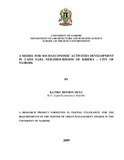| dc.description.abstract | In a modern age where knowledge based industry has increasing dominance, much
private sector production are increasingly becoming home-based. However, in Laini
Saba, this has not been the case and in essence it has lowered the capacity of the income
generating activities, income levels and distribution of work hence income and the entire
socio-economic development in the neighbourhood have not been enhanced. Thus ‘athome’
work as opposed to ‘out-of-the office’ work and even other income-generating
activities that the residents of Laini Saba highly depend upon in order to supplement their
other informal employments have not well been incorporated within their housing
environment. This is positively correlated to low infrastructure provision levels in the
area. As a resulted, housing Laini Saba has done little to encourage social and human
capital formation leading to minimal enhancement of socio-economic development.
Much value in housing is about the ‘housing capability’ which is closely associated with
the housing conditions and accompanying infrastructural services. However, housing
may lack important economic capability for various reasons and so create diswelfare than
welfare to the society, resulting to little or no social-economic gains to the society.
Household development that leads to positive economic benefits occurs in homes, in
libraries and neighbourhood study centres, schools, firms, colleges, universities,
recreational facilities and health centres. The presence and/ or inadequacy of these
facilities has close relationship to the various economic aspects that are related to
housing. The study therefore aims at coming up with a comprehensive model
encompassing neighbourhood economic wellbeing with focus on socio-economic
improvement by advising on the most visible ways of having the above facilities made
available within the informal set ups.
The overall objective of this study was to come up with a comprehensive model for the
improvement of socio-economic activities in Laini Saba as a case study. Specific
objectives included determining the socio-economic activities taking place in the
neighbourhood, establishing the infrastructural impediments for the enhancement of
socio-economic activities, determining the environmental impact of the socio-economic
activities within the area and finally to recommend a suitable model for socio-economic
activities development in the neighbourhood. Shelter problems in Kenya like any other
developing country is due to high urban population growth rates resulting from urban
natural growth, rapid rural-urban migration, a lag in urban infrastructure development to
support shelter development, low purchasing power of the majority of the urban
households, inappropriate building materials and various local authorities’ by-laws
especially for the low-income shelter in addition to unforeseen shelter policy. For
example, housing in Nairobi has tended to mushroom without regard to services, yet
shelter in reality should be backed by a package of services such as land, public facilities,
access to employment and other socio services as well as the dwelling structure itself.
Inadequate housing in Laini Saba has manifested itself in many forms such as poor | en |

